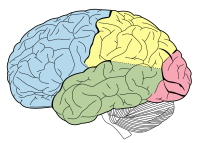
Photo from wikipedia
Abstract For individuals with spinal cord injury, brain–computer interface (BCI) technology offers a means to restore lost sensorimotor function by bridging disrupted neural pathways to reanimate paralyzed limbs. Restoring hand… Click to show full abstract
Abstract For individuals with spinal cord injury, brain–computer interface (BCI) technology offers a means to restore lost sensorimotor function by bridging disrupted neural pathways to reanimate paralyzed limbs. Restoring hand function is a high priority of those with tetraparesis because of the impact that manual dexterity has on independence and quality of life. However, to be useful in daily life, BCI systems need to deliver naturalistic and functional grasp speed, force, and dexterity. In clinical trials, individuals with paralysis have achieved the most dexterous control of grasp using either robotic neuroprosthetics or neuromuscular stimulation orthotics controlled by intracortical BCI systems. Next steps are in progress, with the development of portable components and decoding algorithm optimization to simplify setup and calibration.
Journal Title: Current Opinion in Biomedical Engineering
Year Published: 2019
Link to full text (if available)
Share on Social Media: Sign Up to like & get
recommendations!